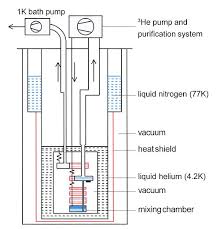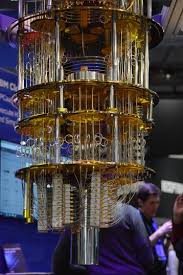This article is written with the intension of providing a brief understanding on Quantum Computing. This is because it is one of the main topics that is currently being evolved at a high rate and it is considered as the future of the field of Computing.
Explanation
Quantum Computing is one of the main fields that use the Quantum theory. In the study of physics, the term Quantum means “the minimum amount of any physical property involved in an interaction”. Quantum theory is basically a discussion about the particles that are in atomic and subatomic levels and it was first presented by physicist Max Plank in 1900.
Quantum Computing is a field that uses the principles of Quantum theory for computational purposes. This uses Qubits instead of bits. Qubits (or Quantum bits) which is the fundamental unit of Quantum Information that can also have a state that would be a linear combination of 0 and 1. Due to the use of qubits, Quantum computing is more advance than the classical computing.
Below figure shows an explanation of the difference between a Classical bit and a Qubit.
The 3 main Quantum Properties that are used in Quantum Computing are,
Superposition
Refers to the combination of two states which are independent to each other and is used to explain the quantum state of a qubit.Entanglement
Refers to the ability of a quantum state of each particle in a set of particles that are generated, interacting or sharing the same space not being able to be described independent of each other. This is because the quantum state of the quantum particles depends on each other.Interference
Ability of a phase of a quantum state being changed due an interference of another state.
Using these Quantum properties, Quantum Computers were designed to do the Quantum computations. These computers use the quantum states to manipulate all possible solutions for a given problem. As qubits must be kept cold to work with them for very long time periods, Quantum Computers are designed in a way such that they can perform at temperatures near absolute zero. ‘Dilution refrigerator’ that is built inside these computers creates a suitable environment for the qubits.
Below figures depict the internal & external structure of a Dilution refrigerator.
Evolution
There can be many motivations for the scientists to develop the concept of ‘Quantum Computing’ which led to the creation of ‘Quantum Computers’. One of the main motivations is that to carry out the "Double Slip Experiment" that explains the principle of quantum superposition. It was observed that the photon which is a quantum particle can be in 2 states at the same time in this experiment. Therefore, a Quantum Computer was considered to be needed to carry out this experiment. Another motivation for the development of Quantum computing is the “Shor’s Algorithm” for large numbers because it required a very long time to factor a very large number into its primes.
The history of Quantum computing starts from the 1920s and can be explained as follows,
1927 - Introduction of ‘Uncertainty Principle’ by German physicist Werner Heisenberg.
1970 - The term ‘Quantum Information Theory’ was mentioned & the idea to join quantum mechanics and quantum information theory was also raised.
1981 - Suggestion of Richard Feynman to develop a computer based on quantum physics.
1994 - Peter Shor’s Factoring Algorithm is considered as the first quantum algorithm.
1995 - Theory of Quantum Error Correction is introduced by several groups including IBM.
1996 - ‘DiVincenzo Criteria’, the 5 basic requirements for creating a quantum computer was suggested.
1997 - Prof. Alexei Kitaev of California Institute of Technology proposes the first ‘Topological quantum error correcting code’ known as the ‘Surface code’ which is considered as the base of the ‘Fault-tolerance quantum computer’.
2001 - The first real quantum computing experiment was done to demonstrate the Shor’s algorithm.
2004 - Circuit QED was invented by Robert Schoelkopf and his collaborators at Yale University.
2007 - A Superconducting Qubit that has reduced sensitivity to charge noise was invented by Robert Schoelkopf and his collaborators.
This was followed by several other improvements in the next years.
In 2017 March IBM introduced the commercially available universal quantum computing systems called ‘IBM quantum systems’. And in 2019 they launched the first integrated quantum computing system for commercial use called ‘IBM Q System One’.
Quantum computing is still being developed so that it could assist in many fields to improve their efficiencies by several companies including IBM, D-Wave, Google, HP, Intel, & Microsoft.
Below is given an image of the IBM Q System One.
Quantum Computing can be applied in various fields to increase the efficiency in those respective fields. Some of them are Quantum Simulation in Medical Science field for drug research and Quantum Cryptography to provide quantum-ready encryption. Several other fields such as Industry, Business, Technology, Health sectors can also be optimized.
Main advantages of Quantum Computing are high storage space, faster execution of tasks than classical computers and ability to increase the efficiency level of the fields it is applied in. It also has some disadvantages such as having a very high cost and having a risk of being able to perform according to their wish against human laws. Therefore, it is required to develop security precautions to provide protection against this risk.
Quantum Computing is the next level of futuristic computing which is being developed and we should be able to understand its functionalities in order to work in parallel with it.







Top comments (2)
When internet security is vulnerable, some ones gonna come and make a quantum encryption algorithm
They are already working on a standard:
NIST Announces First Four Quantum-Resistant Cryptographic Algorithms
nist.gov/news-events/news/2022/07/...
Also e.g. Utimaco has Quantum Resistant Cryptography, on top of traditional encryption
utimaco.com/solutions/applications...